
Early Fall 2023 Uniting the Upper Delaware River Region of PA, NJ & NY 2023PetersValleyCraftFair ExhibitorMapandListInside
2023
MILFORD READERS & WRITERS FESTIVAL READERS. WRITERS. CONVERSATION.
2023
September 22, 23 & 24 - Milford, PA
Ticketed Event Tickets available on Eventbrite
MILFORD READERS & WRITERS FESTIVAL READERS. WRITERS. CONVERSATION. September 22, 23 & 23 SCHEDULE OF EVENTS

Friday, September 22 Location
7 - 9pm Amanda McBroom - An evening of songs and conversation Cash bar opens at 6pm Milford Theatre
Saturday, September 23 Location
10 - 11:15 am Rewriting Shakespeare - Dr. Ismaili AbuBakr, Rob Armstrong, and Lenore Hart Milford Theatre
11:30 am - 1pm Charles Busch, Leading Lady - In Conversation with Dick Scanlan Milford Theatre
2:15 - 3:30pm Vampires, Batman, Wytches, OH MY! - Scott Snyder, graphic novelist with Joe Ott Milford Theatre
3:45 - 5pm Harvey Fierstein In Conversation with David Drake Milford Theatre
5:15 - 7pm Private Author’s Reception - Pass holders only La Posada
FREE Auxillary Panels
11am - 12noon
2 - 4pm
7 - 9pm
SCI FI - Monsters That Make Us with Robert Levy, Dr. Charles E. Gannon, Erika Swyler and Stephanie Feldman, moderated by Karen Heuler
Authors will be selling and signing their books at Golden Fish Gallery, 307 Broad St. Books & Brews event at the Dimmick Inn,upstairs
Pike County Public Library
Golden Fish Gallery Dimmick Inn
12:30 - 1:45 pm The Picture Book - An Experience for a Child with Lindsay Barrett George, author-illustrator Pike County Public Library
2 - 3:15 pm
Young Authors - A Journey in Publishing - Teen authors, Hallie Balogh, Auttie Grace and Owen Carso will discuss their books with librarian, Rose Chiocchi. Pike County Public Library
11 am - 2 pm Meet the local authors to talk with them and buy their books
7:45 - 9:30 pm
Pike County Public Library
The Time’s Right Open Mic - Share your readings and songs - Hosted by Michelle Oram and Kristin Albrecht La Posada
Sunday, September 24 Location
11 am - 12:30 pm
1 - 2:15 pm
What the Dead Know: Learning About Life as a NYC Death InvestigatorBarbara Butcher with crime novelist David Lender
Good Shepherd Episcopal Church
Living Up River, Artful Homes, Idyllic Lives - Barbara de Vries and Emma Austen Tuccillo Waterwheel Cafe
1 - 2:30 pm A Lynching in Port Jervis - Michael J. Worden in conversation with Christa Caceres, NAACP Good Shepherd Episcopal Church
2:30 - 3:45 pm
3 - 4:30 pm
Perspectives on Cancer - Finding Healing and Hope - Tim Sohn with Savio P. Clemente Waterwheel Cafe
Gideon’s Revolution and the Treason of Benedict Arnold - Author Brian Carso and ethicist Joseph Curran
Good Shepherd Episcopal Church
Please note that filming/photography is taking place at the Milford Readers and Writers Festival for promotional and archival purposes. The photographs and recordings made are likely to appear on our website and social media.
After the Main Stage theater presentations on Saturday, you can purchase books and get them signed by the authors at Better World Cafe.
milfordreadersandwriters.com
milfordreadersandwriters.com
Times subject to change
Times subject to change
2
This exhibition showcases the artist’s latest endeavor in exploring the essence of architecture and the intricacies of Nature. Delving into natural elements, he aims to provide answers while also raising questions. Drawing inspiration from abstract ideas, these works offer a unique perspective on the interplay between humanity and the natural world.






3
Publisher & Editor
Amy Bridge publisher@milfordjournal.com
Graphic Design
Maureen Taylor
Associate Editor
B’Ann Bowman
Advertising Team
Amy Bridge amy@milfordjournal.com
Susan Mednick susanmed2@optonline.net
The Journalists
Julia Schmitt Healy • Bob Chernow
Alison Porter • Susan Ridyard

Tim Singleton • Will Voelkel
Eric Francis
The tri-state upper Delaware River highlands and valleys are a place of rare beauty…
Seeing the region and living in it almost aren’t enough. Such beauty should be captured on canvas or film so that one can truly appreciate it, glimpse it in the quiet of an art gallery or museum, or between the pages of a poetry book or literary sketch.
The Journal Group’s mission is to capture these momentary snapshots of beauty graphically and through the written word. We celebrate our area and the uniqueness of the people who live and work in the tri-state region. From Pike to Wayne and Monroe to Lackawanna Counties in Pennsylvania, upriver to Sullivan County and on to Orange County in New York, and to the headwaters of the Wallkill River and
Kimberly Hess kimberlyhess212@gmail.com
Mission
Editorial Readers Robert Bowman
Amy Smith
The Poet
Paulette Calasibetta
along Warren and Sussex Counties’ rolling hills in New Jersey, with quaint, historic towns and hamlets at the center, the Journal Group opens its doors to our communities, businesses and organizations, to serve as a communicative journal of all that we have to offer for those who live here and for those who love to visit us, too.
Publication Information
The Journal Group publishes The Journal ten times a year and distributes it in eight counties in PA, NJ and NY. We assume no responsibility for unsolicited manuscripts. Contents may not be reproduced in any form without prior written permission. We reserve the right to refuse to print advertisements that we deem inappropriate. All rights reserved.
4
Early Fall 2023
Cover Line
Beon Cloud Scoop, installed with backsplash Sculpture by Malcolm Mobutu Smith
Early Fall 2023 Uniting the Upper Delaware River Region of PA, NJ & NY 2023PetersValleyCraftFair ExhibitorMapandListInside
Photo by Jeremy Hogan




5 Contents 10 • art • Malcolm Mobutu Smith 16 • food • September Trifecta 20 • history • Step into the Past 30 • life • Hunt Slonem 38 • nature • Clay Works 6 • journal entry 7 • poem 8 • around the towns 36 • market scope 46 • signs Early Fall 2023
When I was first asked to join a local book club, I wasn’t sure.
I’ve always been a reader, but an independent type. I read what I want and when I want. The subjects, genres, and authors have been varied.

Sometimes, I get on an author kick. I love a book so much that I want to read everything that writer wrote; that’s happened a lot. Other times, it’s a story of a crafter, artist, musician, historical figure, inventor, entrepreneur that catches my eye. Many times, I have more than two books going at the same time, and the subjects could be polar opposites.
When asked to join the club, I didn’t want to say no at first. I wanted some time to think it over. After all, how was I going to feel about being told what to read?
My mom was in a book club for the last 20 years of her life. My mom—the most independent, culturally-rich woman I knew. She lived for museums, Broadway, Off Broadway, Lincoln Center, world travel, and the arts. She was the designated New York City driver for her friends when they were all in their 90s. (Don’t ask!) Obviously, she got something out of being in her book group, and I am my mother’s daughter, so I thought, “Okay, I will look into this.”
It’s been some months down the book-club road, and I’ve learned that even in a solo activity such as reading, there can be a community spirit. I probably would have never read the fiction genre of many of the books on our monthly list, but I feel fortunate to have done so, as I enjoyed them all and my taste in books has evolved.
From what I understand, the structure of a book club can be organized in any way that the group sees fit. Our book club is set up so that every member owns the month that their book is up on the slate. This means that they have the creative choice of where to hold the meeting and what food or drink they want to incorporate. Many times that choice follows a theme in the book we’ve just read.
To sit, compare, and discuss what our takeaways have been makes us pay closer attention to the different aspects of the writing and the plot. We notice that when reading the next month’s selection. I think we’ve become better readers for it, and our discussions have grown.
For me, there have been many positives, besides the obvious one of adding to my constantly growing library and expanding my mind. I’ve cultivated friendships with a group of people who’ve brought a new dimension to each other’s lives.
And for that, I’m glad I decided to join in.
Amy
6 Journal Entry
Dances with Leaves
Leaves of burnished gold take flight Whirling spirals with childish delight
A final pirouette without a sound Before they sadly hit the ground
Their dance is done, they take their place Piously, accepting autumn, with simple grace

Wearing faded colors of garnet, gold and green They serenely exit, from their final scene
The footlights diminished for another year Until the choreographer of Spring, faithfully reappears
Leaves will emerge in sunshine and bathe in the rain A glorious celebration for the dance, to begin again.
-Paulette Calasibetta
Poem 7
Fields of Green Montessori School
Around the Towns
Early Fall
September 1st–3rd
Friday–Sunday
Civil War Living History. Museum Village, Monroe, NY. Demonstrations, exhibits, and hands-on activities. Info: 845.782.8248, museumvillage.org.
September 3rd
Sunday 11 a.m.–4 p.m.
Harvest Festival. Bethel Woods Center for the Arts, Bethel, NY. Farmers market, crafts, live performances & more. $7/parking. Also September 19th, 17th & 24th. Info: www. bethelwoodscenter.org.
September 9th
Saturday 9 a.m.–4 p.m.
Arts & Crafts Fair. Bingham Park, Hawley, PA. Fine handcrafted wares, entertainment, food. Hosted by the Chamber of the Northern Poconos. Info: 570.226.3191, www. northernpoconos.org.
10 a.m.–9 p.m.
General Montgomery Day. Montgomery, NY. Vendors, rides, music, parade, 8K race, fireworks & more. Info: 845.457.9661, www. montgomeryday.com.
1–5 p.m.
Bait and Boat Festival. Lake Marcia Beach, High Point State Park, Sussex, NJ. Kid crafts, fishing contest, story time. Suggested donation $5. Info: 973.875.1471, www. friendsofhighpointstatepark.org.
September 10th
Sunday 11 a.m.–5 p.m.
Orange County Sweet Corn Festival. New Hampton, NY. Corn mazes, fresh produce, entertainment, crafts, petting zoo & more. $10/carload. Info: www.OCSweetCorn.com.

1–4 p.m.
Family Day & Grand Opening of the New Children’s Room. Pike County Public Library, Milford, PA. Guest readings, games, prizes, crafts, snacks. Info: 570.296.8211, www. pcpl.org.
2–5 p.m.
Wine & Cheese Festival. Waterwheel Farm, Fredon, NJ. $70. Hosted by Friends of Karen Ann Quinlan Hospice. Info: 973.383.0115, www.karenannquinlanhospice.com
September 11th
Monday 6:00 p.m.
A Taste of Newton. Trinity St., Newton, NJ. Samples of local cuisine, music. $40–$55. Hosted by Greater Newton Chamber of Commerce. Info: 973.300.0433, greaternew toncc.com/taste.
September 12th
Tuesday 6–9 p.m.
Taste of Warwick. Warwick Valley Winery, Warwick, NY. $75–$85. Food, spirits & music. Sponsored by the Warwick Valley Chamber of Commerce. Info: 845.986.2720, www. warwickcc.org.
Give

your child the best of both worlds!
education using a traditional Montessori curriculum with a large dose of Environmental Education woven into it, creating a beautiful tapestry of academic knowledge and respect for our planet.

Seedlings - Ages 12 mos. to 3 years
Sprouts - Ages 3-6
Oaks - Grades 1 through 8




Fields of Green Montessori School
58 Sandhill Road, Vernon NJ
973-823-0804 • www.fi eldsofgreen.org

5:30 p.m.
Stories in Jazz. Grey Towers, Milford, PA. Roni Ben-Hur Quartet. American classics, light jazz & their own music. $25. Hosted by Kindred Spirits Arts Programs. Info: 570.390.8699, www.kindredspiritsarts.org.
6 p.m.
Spaghetti Dinner & Cabaret. Minisink Pavilion, Montague, NJ. Presented by the Montague Grange #140. $15. Info: 570.228.1166, Facebook: Montague Grange #140.
September 9th–10th
Saturday–Sunday 10 a.m.–6 p.m.
Renaissance Festival. Camp Sacajawea, Sparta, NJ. Music, food, shows, vendors. Tickets: $10–$20. Also September 16th–17th and 23rd–24th. Info: 862.268.0129, www.spar tanjrenfaire.com
September 15th
Friday 6–8 p.m.
Wood, Render & Spencer: Exhibit Opening Reception. Wayne County Art Alliance Gallery, Honesdale, PA. Info: 570.729.5740, wayne countyartsalliance.org.
September 15th–16th
Friday–Saturday
Septemberfest. Milford, PA. Music, family fun & food, all over town. Hosted by Milford Hospitality Group. Info: www.Septem berfestMilford.com.
September 17th
Sunday 11 a.m.–4 p.m.
Meadow Party. Van Scott Nature Reserve, Beach Lake, PA. Puppet show, Close Encounters with Live Birds of Prey, trail walks, crafts. Hosted by Delaware Highlands Conservancy. Free but RSVPs requested. Info: 570.226.3164, delawarehighlands.org.


8
4 Ochs Lane, Warwick, NY Call Us: 845.986.1591 www.ochsorchard.com
Noon–4 p.m.
Sussex County Day. Sussex County Fairgrounds, Augusta, NJ. Music, crafts, vendors, contests. Free. Hosted by Sussex County Chamber of Commerce. Info: 973.579.1811, www.sussexcountychamber.org.
1 p.m.
Catfish Fire Tower Hike & Presentation. Walpack Center, NJ. Hosted by Walpack Historical Society. Info: 973.552.8880, wal packhistory.org
September 21st
Thursday
Networking Golf Tournament. Twin Village Golf Course, Roscoe, NY. Benefits the Sullivan County Chamber of Commerce. 5 p.m. dinner at Roscoe Brewery. Info: 845.791.4200.
7 p.m.
Ghosts & Legends of Sleepy Hollow. Delaware Township Municipal Building, Dingmans Ferry, PA. Performance by Jonathan Kruk. Free. Sponsored by Dingmans Ferry-Delaware Township Historical Society. Info: dingmansferryhistoricalsociety.org
September 22nd–24th
Friday–Sunday

Milford Readers and Writers Festival. Main Stage: Milford Theater, Milford, PA. Individual tickets: $35; Festival Passes $175. Free events around Milford. Info: milford readersandwriters.com.
Fall Flights: Birds & Brews. PEEC, Dingmans Ferry, PA. Guided hikes & bird watching. Beverages from local breweries on Saturday. $225. Info: 570.828.2319, peec.org.
September 23rd
Saturday 9 a.m.–noon
Celebrate a Life 5K Walk. Sussex County Fairgrounds, Augusta, NJ. $15–$25. Benefits Joseph T. Quinlan Bereavement Center. Info: 973.383.0115, www.karenannquinlan hospice.org.
10 a.m.–4 p.m.
National Public Lands Day & Ice Cream Social. Grey Towers, Milford, PA. Re-create Gov. Pinchot’s ice cream social. Free. Info: 570.296.9630, www.greytowers.org.
September 23rd–24th
Saturday–Sunday 10 a.m.–4 p.m.
Festival of Wood: A Celebration of Our Natural & Cultural Wood Heritage. Grey Towers, Milford, PA. Handmade crafts, arts, programs, children’s activities, mansion tours, refreshments. Info: 570.296.9630, greytowers.org.
10 a.m.–5 p.m.
Peters Valley Craft Fair. Sussex County Fairgrounds, Augusta, NJ. $10. (See pages 2529 of this journal for Exhibitor Map & List.)
Info: 973.948.5200, www.petersvalley.org
September 24th
Sunday 10 a.m.–5 p.m.
Fall Foliage Festival. Port Jervis, NY. Music, food, crafts, antique cars & more. Hosted by Port Jervis Tourism Board. Info: 845.858.4000, www.portjervisny.gov.
4:30 p.m.
Gifford Pinchot and the Old Timers. The ARTery Gallery, Milford PA. Presentation by Bibi Gaston about the collection of letters from the foresters of the new US Forest Service to Gifford Pinchot, its first chief. A book signing to follow. Free. Info: 570.409.6754, arterygallerymilford.com.
September 28th–October 1st
Thursday–Sunday
Big Eddy Film Festival, Narrowsburg, NY. Independent films from around the world and our own backyard. Presented by Delaware Valley Arts Alliance. Info: 845.252.7576, bigeddyfilmfest.com.
September 29th
Friday 5 & 8 p.m.
An Evening with Gifford & Teddy. Hotel Fauchére, Milford, PA. A one-night-only play inspired by true events, followed by dinner of original Louis Fauchére recipes. $100. Benefits Grey Towers Legacy Scholarship Fund. Info: 570.296.9630, greytowers.org.
September 30th
Saturday 10 a.m.
Golf Outing. High Point Golf Club, Montague, NJ. $100 includes golf, continental breakfast & dinner. Hosted by Montague Grange #140. Benefits Tunnels to Towers, the Grange & its scholarship program. Info: 570.228.1166, 973.262.8001.
6 p.m.
Barn Dance. Peter’s Europa House, Shohola, PA. Dinner followed by dancing to live music. $85. Benefits GAIT Therapeutic Riding Center and GAIT-ACE Endowment Fund. Info: 717.751.584, gaitrc.org.
September 30th–October 1st
Saturday–Sunday Noon–6 p.m.
Oktoberfest. Hackettstown, NJ. Crafts, music, food & drink, contests, activities. Free. Info: Facebook: Hackettstown Oktoberfest.
October 1st
Sunday 11:30 a.m.–2:30 p.m.
Taste of the Harvest. Seminary Hill Orchard & Cidery, Callicoon, NY. Brunch & concert. Hosted by Delaware Highlands Conservancy. $125. Info: 570.226.3164, www. delawarehighlands.org.

2 p.m.
Three Wishes…A Tribute to Broadway. Newton High School, Newton, NJ. Performance by Harmony in Motion: A Women’s A Cappella Chorus. $10–$20. Info: 973.250.3179, www.harmonyinmotion.net.
Autumn at Flowerland
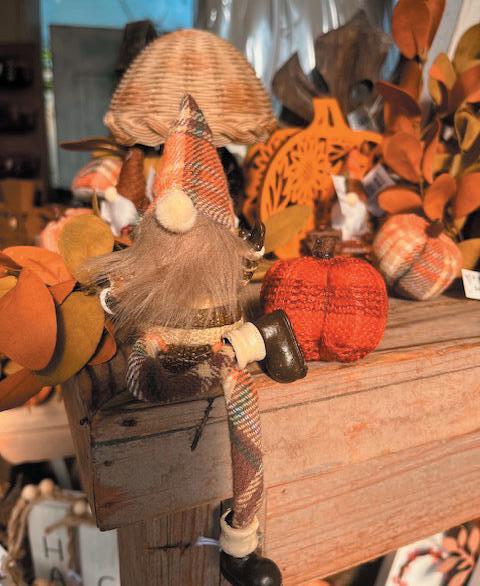
1000’s of Fall Mums, Asters, Ornamental Peppers, Millet, Grasses and so much more! Cozy Home Décor and Sensational Soy Candles will make your house a home this Autumn season.
JOIN US September 22 & 23 for the Autumn Planter Workshop: Create your own Planter complete with Fabulous Fall Mums, Grasses, Asters and Kale and Cabbage.

Christmas at Flowerland
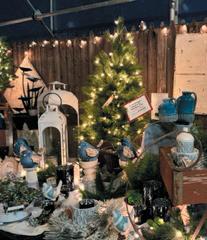

Wander through all the Endearing Displays lled with Ornaments, Holiday Gifts, Sparkling Trees, Farm Fresh Hand Decorated Wreaths and all the Holiday Cheer you can imagine.
December 1 & 2, Christmas Workshop: Join the fun create your own Holiday Centerpiece, Wreath or Christmas Decoration.
December 8 & 15, Flowerland Under the Lights: The most wonderful nights of the season, stroll through all the lighted trees and amazing holiday displays.

568 County Road 519 • Belvidere, NJ 908-750-4567
Open Monday-Saturday 9am-5pm (Closed Sundays) www. owerlandgrowers.com
9
✸
✸ ✸ ✸

10
Courting Unpredictability Malcolm Mobutu Smith
An artist’s process can unfold in a few directions. Some artists make detailed sketches or maquettes before beginning a work, and the result is almost a fait accompli before it’s even been started. Sometimes artists might know pretty much where they’re headed, but open themselves up to veering off the original plan as they work. And others are more immediate in their approach, responding to ideas, instincts, moods, and environmental factors as they pop up. They likely have a personal visual vocabulary and sensibility, but the art is very much born in the moment.
Malcolm Mobutu Smith is mostly in the latter category.
Working this way allows for the unexpected, the daring, the playful, and the “where did that come from?” kind of art. It’s an approach that has served him well in his studio practice.
Smith is an artist and teacher who holds a Master of Fine Arts degree from the prestigious ceramics graduate program at Alfred University in Alfred, NY. Presently, he is an Associate Professor of Ceramic Art at Indiana University in Bloomington, Indiana. He’s also taught classes in Florence, Italy—which is a lovely job if you can get it!
He was exposed to art as a child—both parents were artists. His mother studied painting and drawing and his father, sculpture. So he tells me, “I had an awareness of the arts. They pointed the way—pointed my ship as it were—in that direction.”
Born in Michigan, but mostly reared in suburban Philadelphia, Smith was connected early on to important mentors. At Conestoga High School in Pennsylvania, his ceramics teacher was Paul Bernhardt, who years earlier had taught ceramicist Chris Staley.


When he was only 14, Smith took his first-ever class “outside of high school” with Staley at the Peters Valley School of Crafts in Layton, NJ.
Then in 1988, Smith returned to Peters Valley to work as the studio assistant for Ken Ferguson and other artists, absorbing new techniques and having the chance to exhibit his work in the Peters Valley Gallery. He was “only 16 or 17 years old,” he tells me.
After high school, Smith attended the Kansas City Art Institute for two years, where he studied with Ferguson, eventually switching to Penn State for financial reasons, Continued on next page
11 Art By Julia Schmitt Healy
Left
page: Malcolm in studio.
Photo by Owyn Vernius Johnson Smith
This page:
Bottom left: Glad Hand, back view. Bottom right: Glad Hand, front view. Photos by Osamu James Nakagawa
where he studied with…Staley again! I guess the ceramics world is a small one and very interconnected.
In Alfred University’s MFA Program, he worked with what he refers to as an “amazing faculty” (Wayne Higby, Val Cushing, John Gill, Andrea Gill, Anne Currier, and Doug Jeck) with whom he “forged great and meaningful connections.”
Smith came out of all these experiences ready to share his knowledge. Since then, he has not only taken on full-time, tenure-track college positions, he has also traveled widely, presenting dozens of workshops and lectures. (He taught at Peters Valley in 2019.)
But what of the work? It is usually formed from a wheelthrown vessel. “I start with that and then I improvise,” he says. Since he teaches what might be called classical throwing techniques (meaning that students need to center their clay and pull up a symmetrical pot), he can produce a perfectly beautiful shape that many ceramicists would be happy to leave as is.
Watch one of the many YouTube videos Smith has recorded and you’ll see him gently patting and slicing new edges and shapes into the pliant clay. It is still a vessel, but it begins to take on a new personality, as it were.
With a background in numerous contemporary art forms, such as hip-hop music, jazz, breakdancing, and graffiti, Smith puts a fresh spin on what a pot can be because he uses these unusual sources as inspiration.
Wexler Gallery in Philadelphia, which represents his work, notes: “His abstracted forms become locations for invention and the unexpected…operating as signifiers of aesthetic acculturation and identity politics, reflecting back to us our desires and imaginations.”
His works are playful, unsymmetrical, wild, pointy, and sharp-edged. Some are squat and bent. Others mimic plant forms. Some have a geometric elegance. Others look like they could have grown out of a tree. Many are not functional and can’t actually be used as a cup or vase.
Since Smith has also studied and taught drawing, painting, and printmaking, his constructions and surfaces reflect his interest in two-dimensional disciplines. The pieces are all glazed, not painted, which is amazing because glaze coloration is a lot trickier than paint mixing.

Occasionally, Smith tells me, he’ll begin with a handbuilt, as opposed to a wheel-thrown, vessel. “I exploit the plastic abilities of clay and see where that leads me.” He seems to be always experimenting, always in the moment.
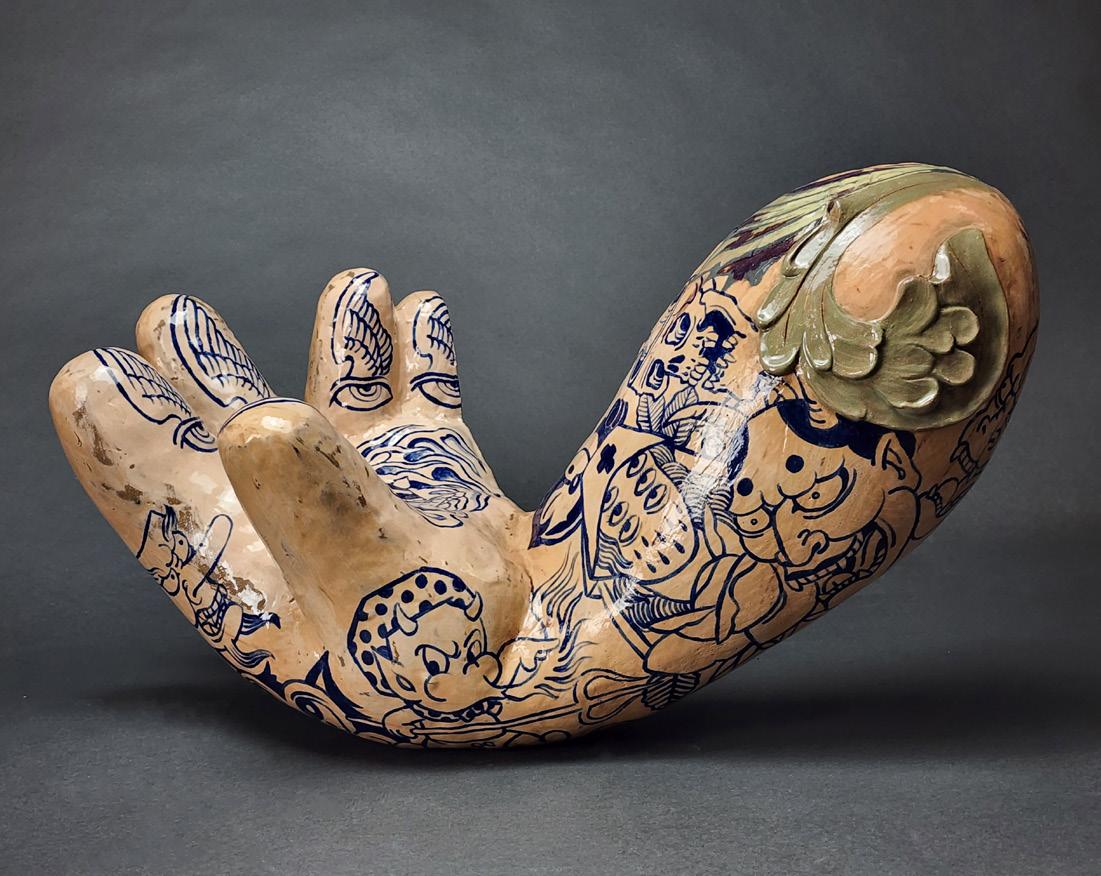
He does not make what we might call “stock pottery.” He doesn’t have a “line” or catalog of objects for sale. He

12 Art Continued
makes art that happens to be made of clay.

Recently, he’s been working on some pieces based on clouds—clouds that are floating. “They are cups or scoops in which vectors overlap, making them look kind of like they’re floating,” he says.
In 2022, Smith had a show at the Hunterdon Art Gallery in Clinton, New Jersey. As part of the exhibition, the Roxey Ballet performed outdoors, responding to his work using the art form of dance. The collaboration was a positive way to experiment and added an extra dimension to the exhibit. (To see this dance on YouTube, search Hunterdon Art Museum Roxey Ballet.)
Some of the most powerful of Smith’s works have a racial connotation. As the Wexler Gallery describes them: “Motivated by his own multi-faceted/multi-cultural background, Smith often incorporates disquieting historical stereotypes or re-imagined heroes within his unassuming shapes, redeploying [the character] in the context of a high art object laid out for aesthetic import as much as cultural critique. The audacity of the character itself is re-doubled by his audacity in representing it.”
Audacity, indeed. Like a lot of hip-hop and graffiti art, fear of the audience’s incensed reaction is not paramount. It is what’s expressed that counts.
These works by Smith are two-sided. Look at a piece
one way, and you see an interesting and engaging shape. Walk around, and Smith surprises you with an unexpected image that takes one back to 19th and 20th century highly unflattering depictions of African-Americans.
We are ill at ease looking at them. Yet, they are powerful. We confront them and we can’t ignore them. They have a “yin yang kind of vibe,” he tells me. “They’re uncomfortable.”
In April, he had several of these works on view at Expo Chicago, a yearly international art fair held on Navy Pier in the city. His work caused a buzz, and some were sold to collectors.

“I continue to try to make arresting, provocative imagery. I court unpredictability in everything I make,” he says.
And when I ask him for closing words, he tells me, “Art is a profound experience for me. It feeds my hunger in a material way. I need to speak what’s necessary to make my voice visible.”
To see more of Smith’s work, visit malcolmmobutusmith.com or search Malcolm Mobutu Smith on YouTube.
Julia Schmitt Healy is an artist, professor, and writer, living and working in Port Jervis, NY. She is represented by Western Exhibitions, (westernexhibitons.com), and her work can also be seen at juliahealy.com
13
Left page: Top: Tattoo side. Middle: Graph side. Bottom: Untitled Platter #3. Photos courtesy of
This page: Left: Making Strides, front view. Right: Making Strides, back view.
Malcolm Mobutu Smith
Photos by Michael Cavanaugh & Kevin Montague




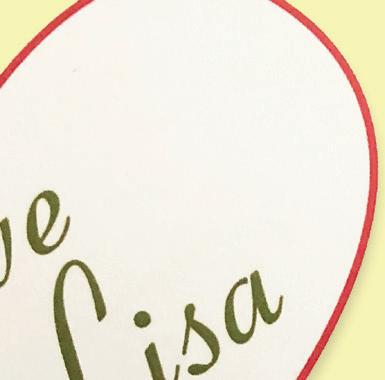









Classes Available: Handmade Pastas Foccacia & Scones Dressings & Marinades Charcuterie Boards Sauces & Pestos Family Favorites And Many More! Come in and Sample our Olive Oils & Balsamics O erings & Pairings: • Fine Olive Oils & Balsamic Vinegars • Private Parties • Kids Camps • Sauces, Dressings & Marinades • Home Accessories & Tablewares • Custom Gift Baskets • Wedding, Shower & Party Favors • Co ee and…Daily Treats We o er a wide range of fine olive oils, balsamics, gourmet food items, salts & spices, tableware and accessories designed to enhance your home dining experience. We make the ordinary… extraordinary! The Shoppes at Lafayette 75 Route 15 Lafayette, NJ 07848 862.200.5003 connect with us! @olivelisanj www.olivelisa.com 14 400 Water Street, Belvidere, NJ 07823 25 E Washington Avenue, Washington, NJ 07882 GRAND OPENING OF WASHINGTON LOCATION SEPTEMBER 16TH! The Ce llar Door Vintage Finds, Antiques, Home Decor Our Hours Monday: Closed • Tuesday: 11am-6pm • Wednesday: 11am-6pm • Thursday: 11am-6pm Friday: 10am-6pm • Saturday: 10am-6pm • Sunday: 11am-5pm EMAIL: THECELLARDOORMARKET @GMAIL.COM SUBSCRIBE TO OUR YOUTUBE CHANNEL: THE CELLAR DOOR ANTIQUE MARKET INSTAGRAM & FACEBOOK: @THECELLARDOORMARKET
SAVE UP TO $2000 on Federal 2023 Taxes
























15
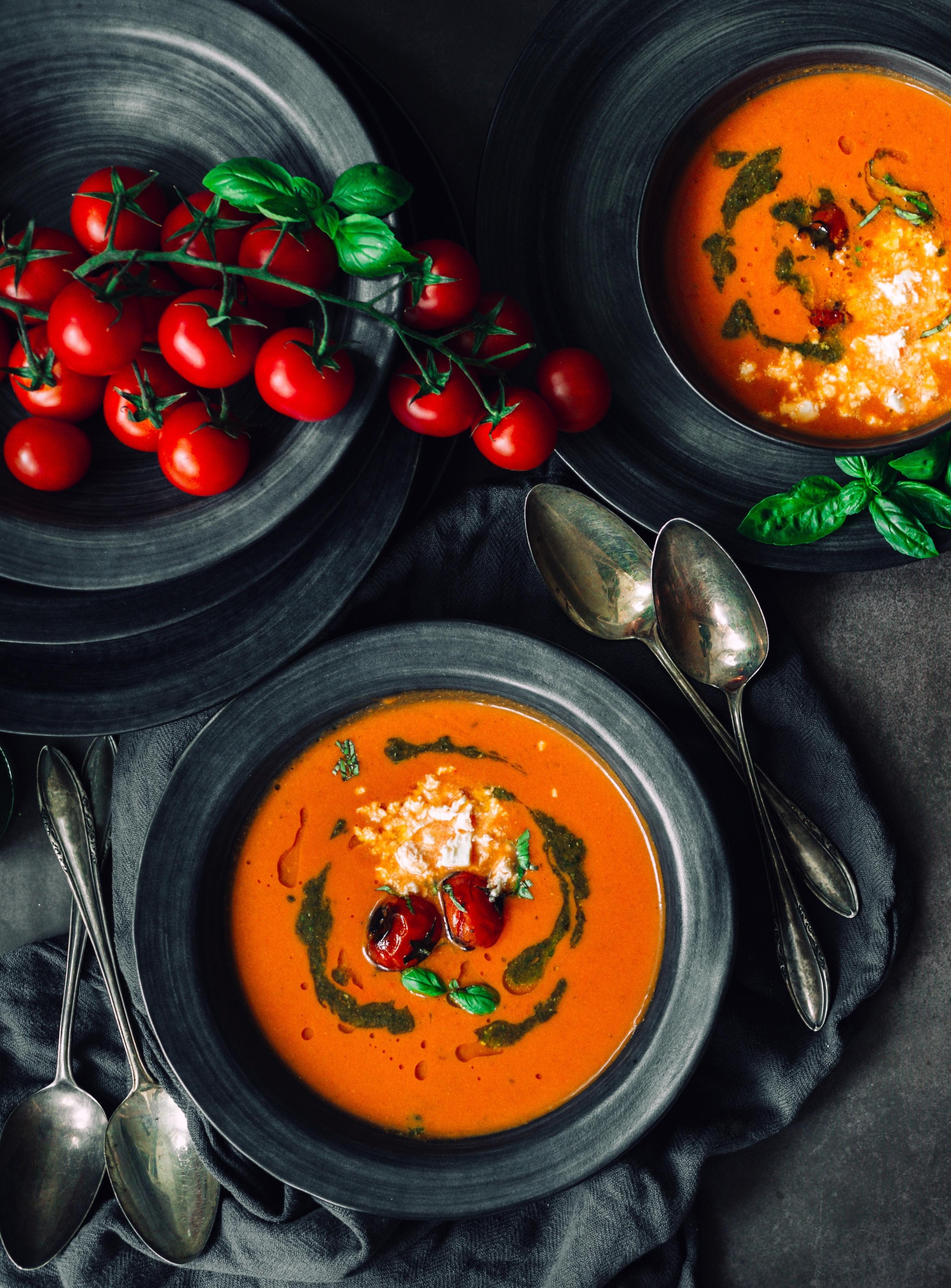
16
September’s Delights
When the first crisp breeze wafts through the air around Labor Day, I venture back into the kitchen to cook again. I greet my pots and pans, ample counter space, and reliable cooktop and oven with fresh energy and inspiration.
I am eager to get my hands on the beautiful bounty of the late summer and transform these fruits, vegetables, and herbs into memorable dishes. I treasure these flavors and savor their memory through the fall and winter until the cycle of farm fresh produce begins again.
This annual reunion between me and my indoor cooking space raises two vitally important questions: namely, how many pounds of tomatoes can I get my hands on to turn into soup, and how much fresh sage can I simmer in brown butter and add to a dish. The answer to these questions varies every year, depending on the weather conditions over the growing season.
Mother Nature is a fickle mistress. Sometimes the tomato season is long and I rejoice. There are years that I have so many tomatoes—from friends, family, and the neighborhood farm stand—that I can make multiple batches of my beloved roasted tomato soup. Some years, I have more than enough to freeze and use over the winter.
This soup is like a celebratory bottle of wine that I break out for special occasions. If I am lucky this year, I will have plenty of tomatoes to enjoy in the coming weeks and will be able to stash a few jars in the freezer as well.
A sage plant grows just outside my front door. It is truly magnificent and becomes more lush and abundant every year. This spring, I harvested some long sage stalks early on and am drying bundles in a cool dry place. It’s a bonanza year for this herbaceous perennial, with a seemingly everlasting supply of oval, mid-green, slightly fuzzy leaves.
There is something so luxurious about fresh sage leaves sautéed in brown butter and tossed in with pasta and veggies. It turns any humble dish into a mini feast. A particular go-to favorite of mine combines gnocchi, delicata squash, and sage brown butter. Yum. Sometimes I wonder how many times could I possibly have pasta with sage butter before I have had enough? I can’t answer that question because it hasn’t happened yet, and I doubt it ever will.
Similarly, summer fruits deserve to be celebrated in their late, last days of ripeness. This time of year is unpredictable as to which fruits will be most abundant. It could
be stone fruits such as late peaches, apricots, or plums, as well as raspberries or even blueberries. I play it by ear and make something that accommodates any random combination of fruits. I simply toss cut-up fruits all together in a bowl, squeeze lemon juice over them to prevent browning, and sprinkle everything with sugar. Let the fruit macerate and rest on the counter for a while to bring out their flavor.
To elevate this humble fruit salad to showstopper status, I serve it with a fancier variation of whipped cream called Presidential Cream. I don’t know where the name came from; I have no idea which president it refers to. All I know is that it’s terrific and addictive.
It is similar to crème Chantilly (heavy cream whipped with confectioner’s sugar) with a little extra ooh-la-la coming from the addition of grated orange zest, Cointreau, and sour cream. I think the sour cream helps hold the mixture together for a couple of days without separating and getting watery.
Presidential Cream definitely can be made a few hours ahead of time—no running around the kitchen looking for beaters at the last minute to assemble the dessert. The stability of this cream is both a blessing and a curse. I make a generous amount…and then I eat all the leftovers a spoonful at a time. I sometimes add a generous dollop to hot coffee for a slightly boozy after-dinner treat.
Here are three of my favorite September dishes that I savor every year. I have refined these recipes repeatedly over time to maximize flavors and minimize active cooking time. In particular, my take on roasted tomato soup has undergone many iterations in my quest for ease of preparation.
After starting with a traditional recipe, I wanted to get away from the time-consuming steps of peeling and seeding the tomatoes. Apparently, the peel and seeds have high levels of antioxidants and dietary fiber. But, to my taste, they both affect the texture, and the seeds add bitterness. Also, on more than one occasion, I have burned the tips of my fingers trying to remove the skins after a quick dip in boiling water followed by an ice bath. I am not a fan of this process.
After spending quite a bit of time tinkering with the recipe, I arrived at an acceptable compromise. This version takes much less time and still tastes great. My solution is to use the biggest tomatoes I can find and scoop out the seeds fast and sloppy over the sink before placing them in
Food By Alison Porter
17 Continued on next page
the pan. Additionally, I peel the tomatoes after they are roasted when the skins slip off easily, albeit messily, while resting in the pan. And I have found a way to use the nutrient-rich peel by drying it and turning it into an intensely flavorful seasoning powder. We call it fairy dust and sprinkle it over everything from pasta dishes to popcorn.
I like to make the roasted tomato soup from all the imperfect, bumpy, misshapen, and split tomatoes. Sometimes the farm stand will save me a box of “sauce tomatoes.” I start in the morning, prepare the tomatoes, put them in the oven, and go about my day while they slowly roast.
The long cooking time fills the house with the tantalizing promise of something delicious. It intensifies the taste and adds layers of flavor not only to the tomatoes, but the garlic and onions as well. It fills me with a sense of well-being and inspires me to greatness. Sometimes I even clean up the house a little.
I enjoy this soup as a satisfying meal by itself or with grilled cheese. It also serves as the starter for my September trifecta of special dishes. It is followed by the brown butter sage gnocchi and ends with the fruit and cream.
These simple and satisfying dishes are like an exclamation point for all the great fresh produce available when the days are warm. Using the late season bounty helps me honor and savor these last few weeks of summer as we transition into the colorful beauty of the fall harvest time.
Roasted Tomato Soup
(Total cooking time 5 hours. Can be done in stages.)
4 pounds or more of imperfect large tomatoes
2 medium yellow onions, peeled, tops cut off and slices made in a grid pattern across the open top side
1 whole head of garlic, top sliced off
½ cup, approximately, olive oil for the roasting pan and soup pot
Basil, one large stem with many leaves or 6-8 fresh leaves. More for garnish.
Salt and pepper, to taste
2 quarts vegetable broth
1 bay leaf
½ teaspoon thyme
½ teaspoon oregano
2 tablespoons fresh parsley
¾ cup heavy cream, optional
¼ cup freshly chopped basil, garnish
• Wash the tomatoes, cut out the stem and scoop out the seeds as best you can.

• Crowd the tomatoes into a lightly oiled 13” by 9” glass pan with the head of garlic and two onions. Tuck in a basil stem. Drizzle with olive oil and sprinkle with salt and fresh pepper.
• Roast at 250 degrees for approximately 4 hours.
• Remove the pan from the oven and let it cool on the counter. (It can be refrigerated overnight at this point and returned to room temperature before proceeding.)
• When the tomatoes can be easily handled, pick each one up, slip the skins off, reserving the skins, and return the tomatoes to the roasting pan. Squeeze the roasted cloves of garlic out of their skins into the pan. Discard the skins. Remove the two onions, cut off and discard their roots and any burned pieces. Return to the pan.
• In a large stockpot, cover the bottom with olive oil and heat on low temperature with thyme and oregano. When it is fragrant, add the contents of the roasting pan. Add two quarts of vegetable stock, parsley, and bay leaf.
• Bring to a boil, then simmer for 30 minutes. Remove the bay leaf and basil. Use an immersion blender or blender to process the soup until smooth.
• Serve as is, with optional basil garnish. Sometimes I swirl in some heavy cream. (You can also cool and freeze in glass jars, leaving room at the top.) Makes 8 large servings.
Food Continued 18
Fairy Dust (Tomato Powder)
(to use the roasted tomato skins)
• Lay the roasted tomato skins in a single layer on a sheet pan lined with parchment paper.
• Place in a 200 degree oven for 3 to 5 hours or until the skins are completely dry, meaning brittle and crispy.
• After cooling, pulse them in a spice grinder or food processor to a powder.
• Store in a cool dry place, like the refrigerator.
• Add as a flavor enhancer to a variety of dishes. Try it on popcorn with Parmesan!
Gnocchi with Delicata Squash and Sage Brown Butter
12 oz of potato gnocchi
2 delicata squashes, washed, cut lengthwise, seeds removed and then sliced into 1” half moons

4 ounces (½ stick) butter
18 or more sage leaves, washed and patted dry
⅓ cup pine nuts, lightly toasted
Grated parmesan cheese
• Place one cup of vegetable broth and 2 sage leaves in a medium pot. Add the squash, bring to a boil then reduce the heat.
• Simmer, covered, for 6 to 8 minutes until the squash is tender. Remove the squash and set aside, keeping the liquid to cook the gnocchi in.
• Add water as needed and prepare the gnocchi according to directions. Reserve.
• In a large saucepan, melt the butter on medium heat. Add the squash skin side up and sauté lightly to crisp the edges, 1-2 minutes. Remove the squash, and place in a serving bowl.
• Add the sage leaves and simmer until the edges are crispy. The butter should be golden brown or slightly darker. Watch carefully, as it can easily burn.
• Toss the cooked gnocchi with the squash in the serving bowl along with the sage brown butter. Adjust seasoning, according to taste.

• Top with pine nuts and parmesan cheese as desired.
• Serves 4 as an appetizer or side dish.
Presidential Cream
2 cups heavy whipping cream
½ cup powdered sugar
1 teaspoon grated orange peel
¼ cup Cointreau or triple sec
¾ cup sour cream
• In a large bowl using an electric mixer, beat the heavy cream and powdered sugar together until light and fluffy.
• Grate in the orange peel, along with the Cointreau and sour cream and beat until the cream is thick and forms stiff peaks.
• Serve with fresh fruit or cake. Serves 8.
19
By Tim Singleton and Susan Ridyard
Keeping the History of Dingmans Ferry Alive

The Dingmans Ferry-Delaware Township Historical Society, founded in 1994, preserves the rich history of this unique area. One of its crowning achievements has been its museum, which opened in 2008.
Over the past years, the museum has been expanded and improved, with over 3,000 unique artifacts in its collection, including eight rooms, illustrating the local history of the Dingmans Ferry area. Each of the rooms focuses on a central theme, and a push-button audio recording is available to narrate through the displays.

Step into the past with us. The Museum of the Dingmans Ferry-Delaware Township Historical Society delights visitors of all ages with its distinctive artifacts and local stories.
Room 1 • Native Americans and Early Settlers
The Minisink Valley was the home of the Lenni-Lenape tribe of Native Americans who for centuries revered this fertile area for hunting, fishing, and farming, as well considering it a spiritual link to their ancestors. This room contains many artifacts and paintings of Native Americans.
In the early 18th century, European settlers moved into the area. One of the earliest settlers was Andrew Dingman who came here to the frontier in 1732. Dingman constructed a ferry to allow access to the west side of the Delaware River and created a village that still bears his name.
Trading with New York and New Jersey increased rapidly, and, eventually, the first of several bridges was built to span the river. The bridge is still in use at Dingmans Ferry. It is owned by the Dingman Choice Company and is the last privately owned span on the Delaware River.
Room 2 • The Kitchen
The next room on the museum tour is dedicated to the early homemaker who had the arduous work of maintaining the home and meeting the needs of the family. Her many jobs included cooking, baking, churning butter, preserving food, cleaning, doing wash, attending the garden, etc. Of course, all of these tasks were performed without the benefit of electricity or modern appliances. On the walls and counters, you’ll see many of the hand utensils used, as well as kitchen staples from earlier times.
Room 3 • Military History & Veterans
The Military History room is in remembrance and in honor of all Dingmans Ferry veterans who served to create and protect our country. Many young men and women sacrificed their safety to fight. Some returned home with
History
20
serious injuries, and others made the ultimate sacrifice of dying for their country.
The room contains military artifacts and a listing of local veterans who served in wars and conflicts, from the Revolutionary War and Civil War up to present-day military conflicts involving the United States.

Room 4 • Death of a Village
The village, originally named Dingman’s Choice and later renamed Dingmans Ferry, began as a mill and residential town. Over time, the area attracted many visitors and residents due to its picturesque landscape, waterfalls, rivers, and natural habitat. However, the Delaware River occasionally flooded, causing major property damage, and in 1955, a major flood occurred.
In the 1960s, the U.S. Army Corps of Engineers recommended that the river be dammed to Tocks Island, just above the town of Water Gap, to create a reservoir.
To accomplish this, it would be necessary to demolish the town of Dingmans Ferry, along with surrounding areas on the PA and NJ sides of the river. All buildings, houses, stores, farms, hotels, schools, churches, and even cemeteries had to go.
Eminent domain was enacted if anyone refused to sell. After the people moved out and demolition began, the
government reevaluated the project and decided the dam would not be feasible after all. The controversial project was ultimately canceled in 1978, and the land was transferred to the Delaware Water Gap Recreational Area.
Today, as you drive along Route 209, the major thoroughfare of the former village of Dingmans Ferry, you will see that nature has reclaimed the land.
Room 4 depicts the village of Dingmans Ferry in photographs and maps. There is also a video about this sad time in our history. Cherished memories and old photographs are what remains of the village now. (The area called Dingmans Ferry today is an unincorporated community in Delaware Township.)
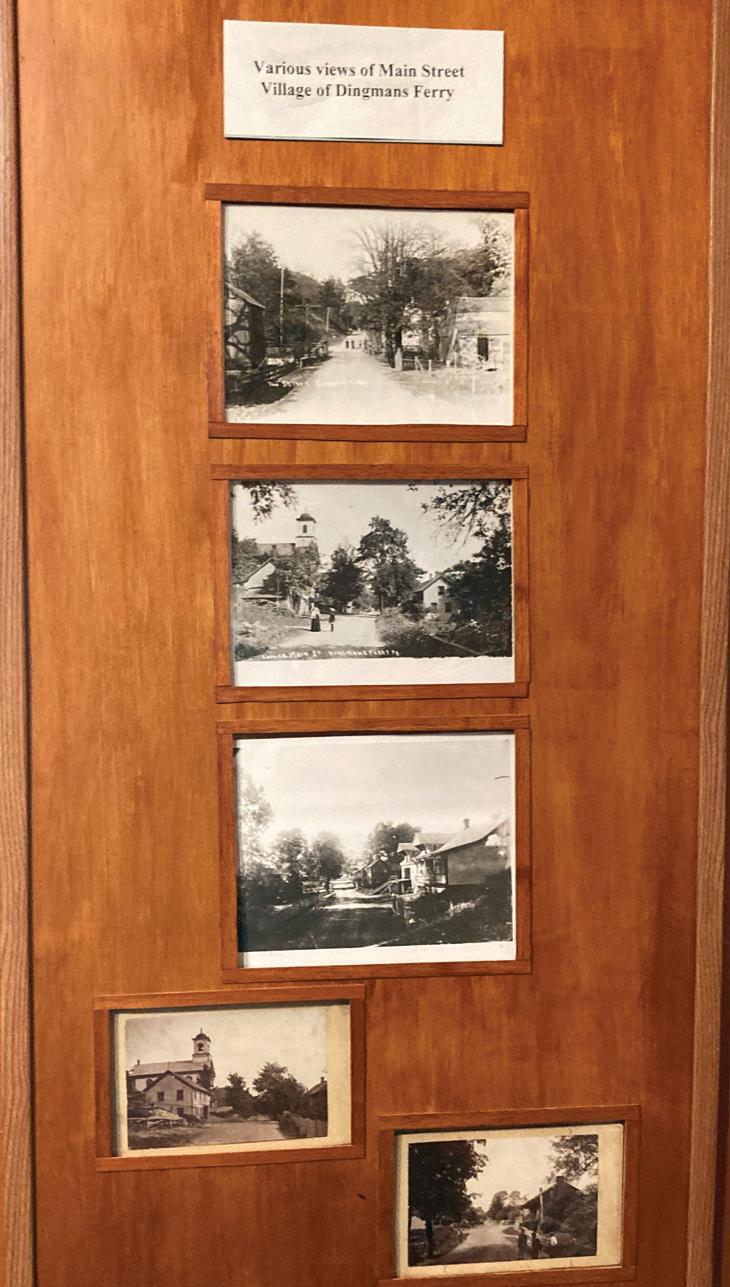
Room 5 • School Room
This room resembles a typical one-room schoolhouse, which was common during the early days. Students in all grades attended school together, with one teacher teaching them in a single classroom.
Education has always been an important aspect of life in Dingmans Ferry. Our first school, the Academy, was constructed in the early 1800s. The Academy school was built next to the cemetery, across the street from the Dutch Reform Church on Route 209. This school was rebuilt three times after being destroyed by fire in 1870, 1888, and 1901.

21
Continued on next page
Photos courtesy of Susan Ridyard
Room 4
Room 3
Room 5
Other schools included the Cole school, built in 1867, the Center School in 1895, and Brett School in 1931. Over the years, these schools were rebuilt many times after fires.
In 1933, a new Delaware Township consolidated school was opened on Schoolhouse Road off of Route 209. This school operated for nearly 50 years, before being closed when the Dingman-Delaware schools on Route 739 were built.
The School Room at the museum contains many photographs and materials showing education from long ago. What has never changed is the dedication of our teachers to the important concept of learning.
Room 6 • Tools
In early times, the development of this area was undertaken by property owners, tradesmen, and merchants, with many projects being community efforts. A project’s success was greatly influenced by the tools and equipment available to complete the job at hand. This room displays many of the hand tools used by early residents for building and farming.

Room 7 • Marie Zimmermann Room
Marie Zimmermann was a well-known resident of Dingmans Ferry. She was a nationally acclaimed sculptor, painter, wood carver, jeweler, and blacksmith. Her work is displayed in many museums, including the Metropolitan Museum of Art.
Marie was also an avid outdoors woman, who fished and hunted on her family’s farm off of Route 209. In 1912, she personally designed her home there in the French provincial style. The farm was in full operation until 1969 and
is now part of the Delaware Water Gap Recreation Area. This room at the museum contains examples of Marie Zimmermann’s art and furniture that she designed.


Room 8 • Library and Former Hotels
The last part of the museum tour includes the library. This part of the museum formerly housed the Delaware Township Public Library, which was in operation for many years. The library provided information and reading entertainment for residents, and after it closed, the museum expanded its space.
This room is also dedicated to the hotels and resorts that were popular in this area from the mid-1880s to the early 1900s. The stunning scenery of waterfalls, rivers, and forests attracted many visitors. The resort industry was an integral part of the area until the Tocks Island Dam project caused the demise of these businesses.
The Dingmans Ferry-Delaware Township Historical Society takes pride and comfort in commemorating the colonial village of Dingmans Ferry by promoting historical research. It especially focuses on the discovery, preservation, and publication of its history by collecting atlases, books, deeds, engravings, genealogies, journals, letters, manuscripts, maps, newspapers, paintings, and photographs. Please contact us to discuss gift donations or volunteer opportunities at the museum.
The Historical Society hosts free presentations at the Delaware Township Municipal Building on 116 Wilson Hill Rd. in Dingmans Ferry. Check our website calendar for more information: dingmansferryhistoricalsociety.org.
The museum is located at Akenac Park on Route 739, Dingmans Ferry, PA. It is open from 11 a.m.to 3 p.m. on the 2nd Saturday and 4th Sunday of the month from April through November. The museum is free and available to members and groups for private tours.
22 History Continued
Room 8
Room 7



























Pick Your Own Apples Fall 2023 You Pick Pumpkins & Apples Visit Our Beautiful Fields OPTICAL GALLERY Quality Eyewear Tues 9-5, Wed 9-6, Thurs-Fri 9-5 Sat 9-1, Closed Monday Mark & Tammy Zaleski Owners/Opticians 322 Broad Street • Milford, PA 570.296.4891 Hair Cuts • Color • Facials Waxing • Mani Pedi 204 E. Harford St., Milford, PA • 570.296.7221 Email: thelegacymilford@gmail.com

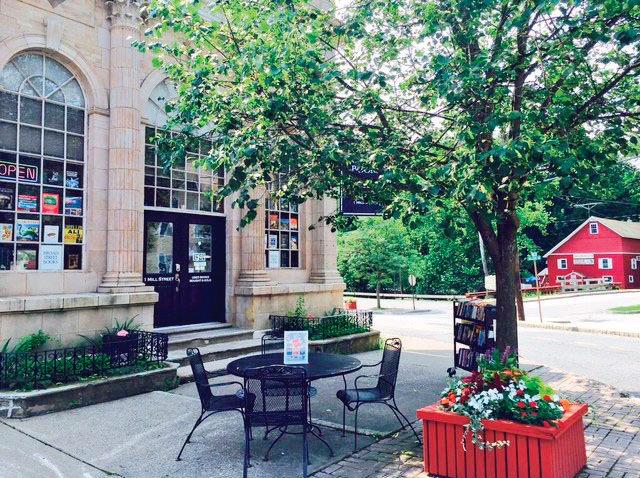

Used Books Bought & Sold Mon-Sat 10-6 Sunday 10-3 1 Mill Street • Branchville, NJ • 862.268.5184 www.broadstreetbooks.com Broad Street Books 24












$10 Adult FREE for Children Under 12 PetersValley.org CRAFT FAIR 53RD ANNUAL Fine Craft Handmade 100+ Artists Meet the Artists Food & Drink Family Activities Sussex Co. Fairgrounds @PetersValley September 23rd & 24th 10am-5pm A WEEKEND of Fall Fun! Thank you to our sponsors Have a one-of-a-kind experience and buy unique art from craft artists at this annual Fall event!
Jusell 25
Artist:


27


28


29

30
Hunt Slonem.
Photo by Charlie Rubin
Art to the Hilt
Hunt Slonem
Google the keywords Napoleonville + British church pews + Scranton armory + Bunnies + Saint Pierre Toussaint + Hawaii + Whoopi + Guggenheim + diamond dust + Gatekeeper + Milford Pennsylvania and you’ll come up with but one response: Hunt Slonem.
Painter, decorator, collector, portraitist, lifestyle trendsetter, aviarist, muralist—that just barely scratches the surface of Hunt Slonem, 72-year-old artist and nature lover. The combination of talents in whole (if it’s possible to call a description of this man “whole”) spells out what friends, art critics, and admirers alternately call friendly, wildly talented, and prolific.
“Hunt creates and lives in a world of fantastic art in all forms,” says his friend and publisher Marta Hallett, whose company G Editions has published four of Slonem’s books. “And I use the word fantastic advisedly. Hunt’s body of work reflects fantasy, allegory, symbolism, color, whimsy, and so much more.”
“I’ve enjoyed a good life, doing exactly what I always wanted to do,” says Slonem. “I still paint every day.” Inspired by his grandfather, who collected art and painted, Hunt eschewed the naval military life of his admiral father, which had meant moving from place to place, including Minnesota, Hawaii, Washington State, and Nicaragua.
He was an exchange student in Nicaragua during his high school years, and he has more recently reconnected with the area through Fr. Enrique Salvo, the rector at St. Patrick’s Church in Managua. “I found that Nicaragua’s jungles and exquisite habitat brought out my mystical side, and I became enraptured with its lore, myths, and saints, particularly Saint Pierre Toussaint, a former slave who became a prominent New York City hairdresser. This fascination is also reflected in some of my works.” The natural beauty that surrounded him in the Nicaraguan environs led him to focus on capturing nature on canvas, especially animals.
Slonem’s subjects in the animal world have included bunnies, butterflies, and birds, and some of his most popular art books are in fact titled Bunnies, Butterflies, and Birds. “We can barely keep up with demand for Bunnies,” claims Hallett. “We’re going into our fourth printing on this $95 book, and we will be releasing Bitty Bunnies, the exact same book on a smaller scale at a lower price point.” Whoopi Goldberg has called Hunt Slonem her “favorite artist.”
In addition to painting in the Neo-Expressionist style, which spotlights highly textural applications of paint and vividly contrasting and bright colors (his favorite is ultramarine blue), Hunt also has a passion for saving and reclaiming historical grand structures and period furniture, mostly from the 19th century.

He primarily works out of his studio in New York City, where he once housed over 100 tropical birds in an aviary. He also owns or rents five historic homes (including a castle), a Manhattan studio, and apartments in cities as varied as Great Barrington, Massachusetts; Napoleonville, Louisiana; and Scranton, Pennsylvania.
In Scranton, he rents the Watres Armory, named after the Pennsylvania National Guard Brigade’s Colonel Louis Watres, which is a massive 102,000 square-foot structure that opened in 1900 and closed in 2011. He had more than 500 truckloads of his art moved from his studio in New York to the armory.
He has restored his historical structures with period artworks, furniture, busts, and rugs. The results are documented in the book, Gatekeeper: World of Folly (Assouline Publishing, 2018). Hunt has a new book coming out this month: The Spirited Homes of Hunt Slonem (Gibbs Smith, Continued on page 33
31 Life By Will Voelkel
Painting by Hunt Slonem

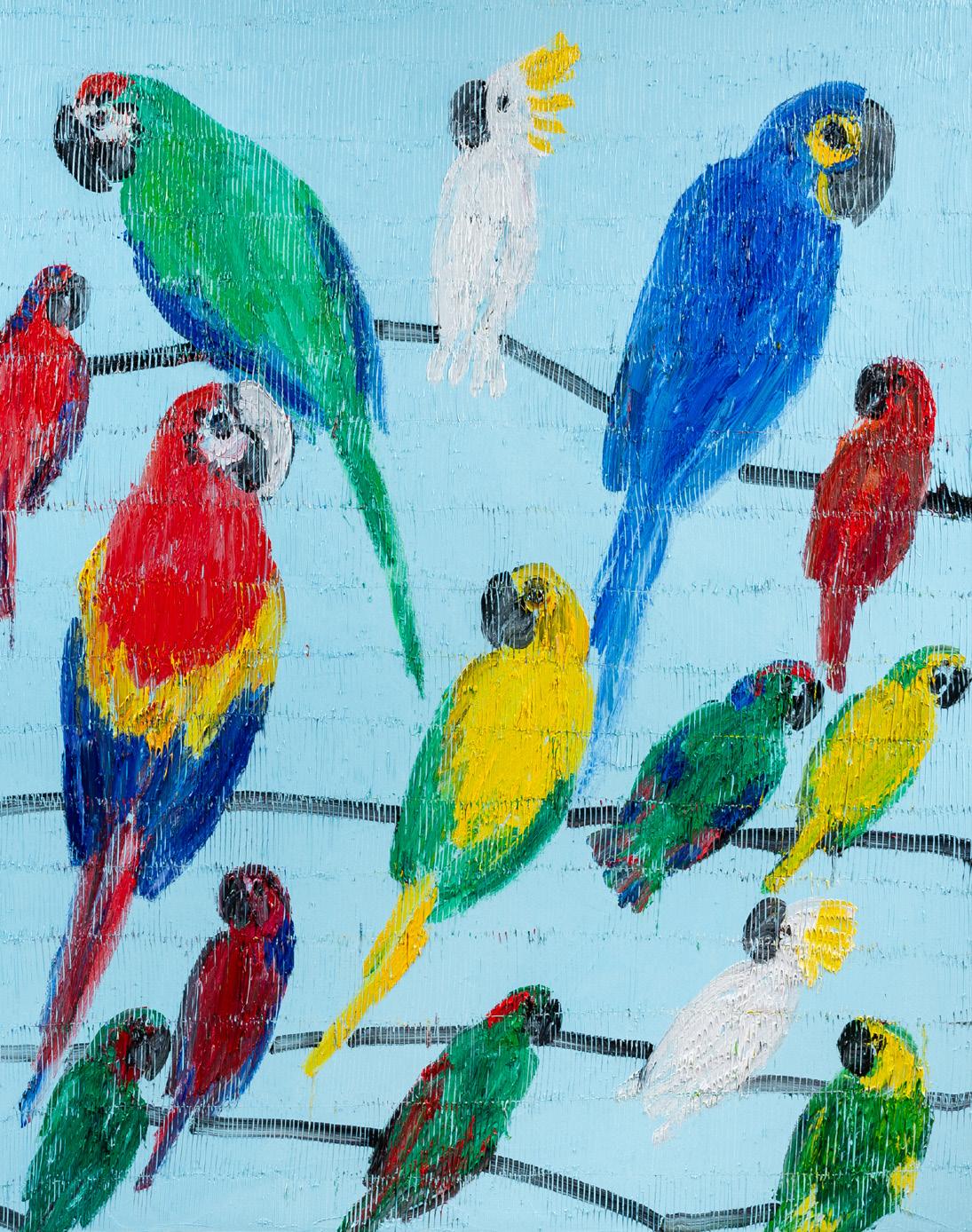


32 Life Continued
Paintings by Hunt Slonem
2023), aptly named because he has witnessed ghostly occurrences—“Friendly,” he assures—in the homes. This is the first book to encompass all of his homes
“I enjoy taking old furniture pieces and updating them with contemporary fabrics, but still adhering to their place in history,” he explains. Among the many historical pieces in Scranton are Gothic church pews that he imported from an old church in England. The armory and Hunt’s restorations and collection were prominently featured in 2018 in Architectural Digest, where he explained that he also likes to incorporate patinas of age that ordinarily take hundreds of years to create. His paintings and other works have included materials such as metallics and diamond dust.
Slonem’s works can be found in the permanent collections of 250 museums around the world, including the
Metropolitan Museum of Art, the Solomon R. Guggenheim Museum, the Whitney Museum of American Art, and the New Orleans Museum of Art.
So what keeps this septuagenarian inspired these days? “Installations in large spaces, which I’ve always enjoyed,” he explains. “I look forward to creating art in giant spaces with giant walls, as well as in spaces that mimic nature.”
One of his large sculptures of mosaic, bronze, and glass will be featured in an exhibit at the San Antonio Botanical Gardens in 2024, and he is looking forward to his upcoming show in Milford, PA, at Forest Hall Studios.
“Working with curators Chris Makos and Paul Solberg has been energizing,” he says. They have been friends since they met in New York in the 1980s, where he also came to know Sean Strub, mayor of Milford.
“I’ve never met a more prolific artist,” says Solberg. “For
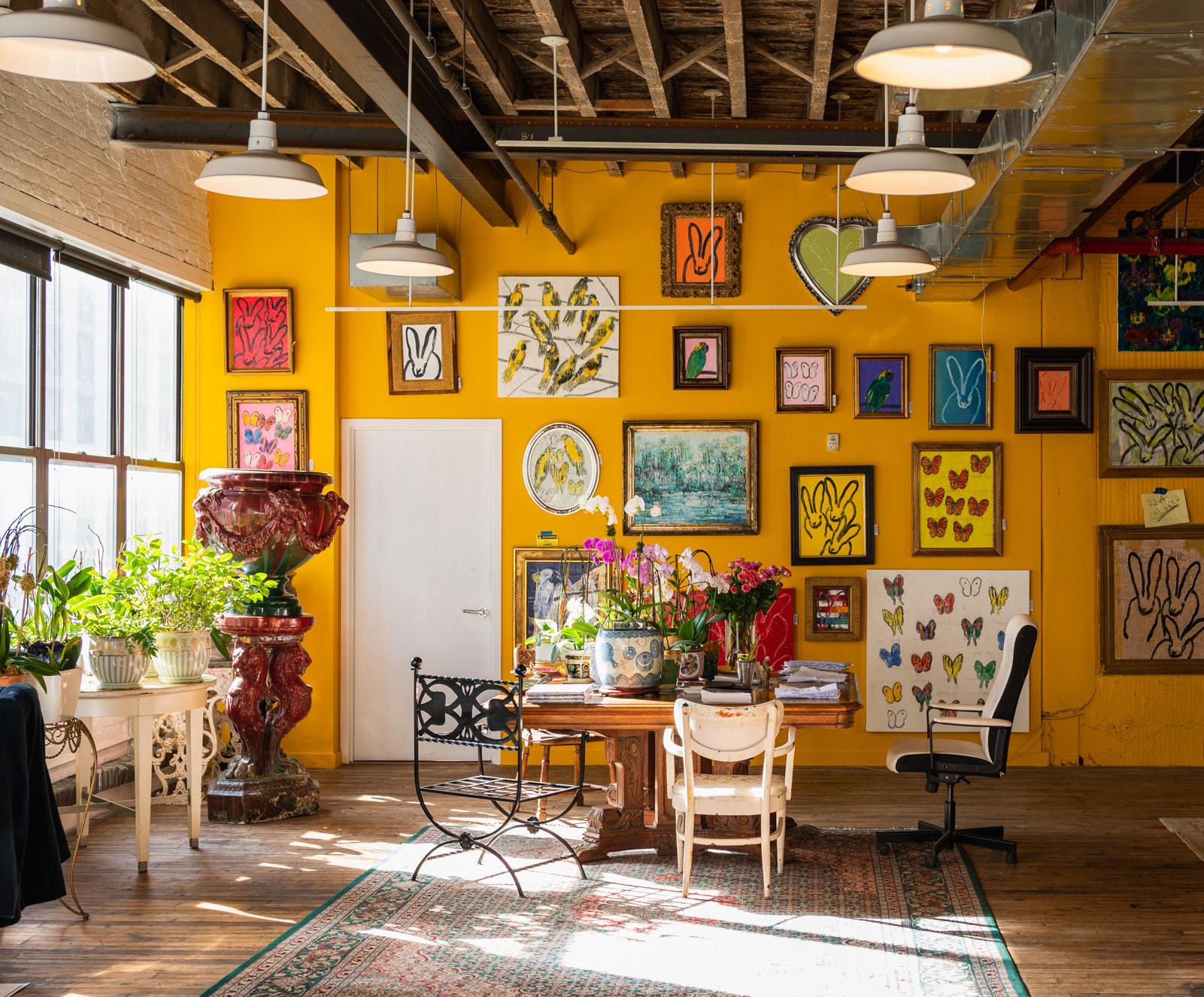
33
Hunt Slonem’s Manhattan studio.
Continued on next page
Photo by Charlie Rubin
Hunt, to live is to paint. He’s given his life to the natural world, living in the world he paints. Even with his human portraits, he reminds us of the relationship of the human being and the natural world.”
Slonem’s show opens on September 23rd at Forest Hall Studios, and Chris and Paul have planned a grand opening reception. Other featured artists whose works will be displayed at Forest Hall will be the ceramic artist Bruce Dehnert and photographer Vincent Caruso.


“What’s especially exciting about this show at Forest Hall is that we’ll be installing 189 of Hunt’s works that have not been seen by the public in decades, or ever,” enthuses Chris Makos. “These are works of art that have been rolled up for years, most recently at the armory. No other exhibit of his has featured this particular body of work.”
It’s a natural fit for Forest Hall Studios, given the historical significance of the building itself, Gifford Pinchot’s place in environmental history and conservation, and












Pike County’s overflowing bounty of nature. Hunt adds, “One of the things I enjoy most about my wide array of artistic endeavors is getting people’s reactions. There’s no special meaning I ascribe to any of my works, so it’s very satisfying to hear people’s reactions, whether they like a particular piece or not. They see whatever they see and interpret however they will. I just hope my works bring joy to people, especially in these turbulent times.”
Finally, did we mention that Slonem has shows that have opened or are opening in August and September in London, Vienna, and Singapore? “And more to come,” he promises. Prolific indeed, a man who not only creates art on a large scale, but lives life on a large scale as well.
Will Voelkel is a New York native turned full-time Milford resident and a frequent contributor to The Journal. He enjoys traveling, kayaking, flipping houses, and executive producing comedy headliner performances in Northeastern Pennsylvania.
DON’T MISS ANOTHER SUMMER! ORDER YOUR POOL NOW FOR NEXT YEAR AND SAVE





















845.374.3969 www.royalpoolsandspas.com Doughboy Pools* up to $700 OFF Radiant Pools* up to $800 OFF *Only for Fall 2023 installation Infrareds/Customs/Outdoors Traditional/ Combos IN-STOCK SAUNA SALE ONGOING SEPTEMBER POOL CLEARANCE SALE $AVE PROFESSIONAL POOL CLOSINGS! SCHEDULE YOURS NOW CALL 845.374.1124 New Hampton, NY 5008 Route 17M Newburgh, NY 49 Route 17K Poughkeepsie, NY 2294 South Road Highland, NY 604 Route 299 4 LOCATIONS SUMMER SALE LABOR DAY PROMOTION September 1st-11th, 2023 SAVE UP TO $1500 Sundance Spas Instant Rebate or 0%APR for 36,48,60 Months CREATE
ORDER YOUR WINTER SAFETY COVER FOR EARLY ARRIVAL
MORE MEMORIES
CALL OUR SERVICE DEPARTMENT FOR WINTER POOL SERVICES 34 Life Continued







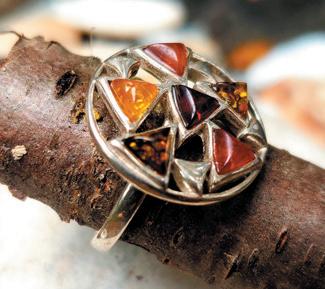



Check Out Our New Website: completekitchen&baths.com AWAKE N ING N Y 35 Front St, Port Jervis, NY 12771 845.672.4311 www.awakeningny.com Tea Room High Tea Pastries Organized Parties Crystals Jewelry Antiques Art Decor Yoga Classes Numerology Energy Healings Psychic Readings 35
Nicole Francoeur graduated from the University of Delaware with a BFA in printmaking and silver smithing, which is not a big stretch from owning an art framing shop if you think about it.
“My jewelry professor always said to look at all artwork from front to back, and that’s exactly what I do with my framing,” Nicole explained. “The back and inside, which a client doesn’t see, are just as important to me as the front. I approach framing from a preservation/ conservation point of view.”
Nicole’s passion for framing goes beyond the ordinary. She’s been in business since 1998, starting in Madison, NJ, and then moving to Sparta six years ago. Starting her 25th year in a new location at 270 Sparta Ave. in the Upper Lake Plaza, she is the last independent picture framer in Sussex County.
“I have over 8,000 frame samples in my shop, but I rarely take more than a dozen out while designing,” she said. “Some questions I ask my client include: What’s the value of the object to be framed? Does it have sentimental value? Where is it going to hang? And then, what’s your aesthetic—minimalist and streamlined or museum style and ornate? There’s a balance between framing for the artwork and the room it is going to hang in.

“My most creative job has been framing a stadium seat signed by Joe Namath so that it didn’t just look like a piece

of plastic on the wall. My most pleasurable job was creating a frame to go on a reproduction of W.F.K. Travers’s oil on canvas of a life-size portrait of Abraham Lincoln. The painting is 9 feet tall! The original, painted in 1865, went to the Smithsonian while their Lincoln portrait is out for restoration. We replaced the original in Madison Borough’s Council Hall with a reproduction painting and similar 22 kt. hand-carved frame.


“I love to educate my clients about their artwork. What the medium is, the history of the artist, and even auction records help a client know what they have. One of my clients brought in a painting to be reframed. It turned out their original frame was handmade by the famous framemaker Henry Heydenryk, and I sold it for them at auction for $45,000.
“I love art history, researching a piece, and identifying artists and mediums. Forgeries fascinate me— World War II stolen art, authentication practices, legal battles over art—I will track down information about my client’s artwork. I took an Art Appraisal Certificate at NYU so I know how to look for information.

“I developed many resources for painting, paper, or frame restoration. If I cannot do something, I have folks who can do it for me. I tell my clients, if you have an idea of what you want, I can make it come true. I love this industry.”



36 Market Scope Rose City Framemakers Custom Picture Framing
a curated colection of over 5000+ choices from America’s best
Art Prints and Antique Prints Fine Art Prints from Island Arts International Painting Restoration
Tuesday - Friday 10-6 Saturday 10-5 Nicole L. Francoeur, BFA, CPF - Proprietor 270 S. Sparta Ave. • Suite 107 973.660.0922 www.rosecityframemakers.com
With
Fine
Hours:













CHARMING MILFORD Route 2001 (Water St.) 570-296-9610 BEAUTIFUL LAKE WALLENPAUPACK Route 6 • 570-226-9726 HISTORIC DOWNTOWN HONESDALE Church & 6th Sts. • 570-253-1860 VanGorders.com 37 Draperies & Shades • Blinds & Shutters • Bedding & Reupholstery • Fabrics & Wallpaper NJ Family Business of the Year National Retailer of the Year Family Owned Since 1934 Hunter Douglas is on SALE! Save up to 30% OFF* If you are looking for Custom Window FashionsCall the Experts! Our professional decorators will come directly to your home or office. To request an appointment, call or visit us at windowfashions.com Silhouette® Quartette® Window Shadings shown *Excludes restricted products Call Today 877-722-1100 for your FREE consultation. Branchville - Sparta Green Brook - Paramus Livingston - Lebanon MWF The Journal 2023.pdf 1 8/8/2023 6:39:22 PM The Body Code TM could help you! Discover the advanced wellness method developed by holistic chiropractor Dr. Bradley Nelson. It’s built on the premise that true health comes from being balanced in 6 different ways: ENERGIES • CIRCUITRY • TOXICITY PATHOGENS • STRUCTURAL • NUTRITIONAL Body Code TM sessions are simple and non-invasive CALL NOW (570) 409-1171 Book an appointment to discover how The Body Code TM can help you. Maureen A Caska, Certified Practitioner 801 Broad Street, Milford, PA 570.409.1171 • tlcsalonandspamilford.com Maureen A Caska, Certified Practitioner
By Bob Chernow
Playing with Mud
The Nature of Clay
Soft, squishy, wet, sticky, slimy. Doesn’t every child play with mud?
Years ago, I remember as a child searching local streams in Monmouth County, NJ, for fossils that would wash out of the adjacent cliffs after a heavy rain. Most of the time, my treasure hunt yielded glassy brown, pencilpoint-like skeletal structures from ancient squid called belemnites and small clam-like shells called brachiopods. If I was really lucky, I might find a shark’s tooth.
These juvenile adventures may have steered me toward a career as a geologist, when I learned that the cliffs were made of clay, which is the word geologists use to describe the smallest eroded particle from a larger rock. A single particle of clay is invisible to the human eye, but put millions of particles together with water and we have what
is commonly known as clay, or to a kid, dirt and water make mud.
Clay has a rich history. Clay pots and writing tablets were used by prehistoric people thousands of years ago. In New Jersey, clay pits around the state were mined for tableware and fire brick in the mid-1800s, and Native Americans fabricated clay pots hundreds of years earlier.
Since I am familiar with the scientific side of clay, I wanted to learn more about the artistic aspect of clay. Earlier this year, I took an introductory pottery class at the Center for Contemporary Art in Bedminster, NJ, under the direction of teacher and ceramic artist John Reinking, whom I interviewed for this article. Reinking’s work has been affiliated with Peters Valley School of Craft in Layton, NJ, since 2006.

38
Nature
I also had the pleasure of meeting and interviewing David Bogus, artist and Ceramic Studio Head at Peters Valley, as well as his ceramic studio assistants Persis Wade and Ryder Gordon.
Both Reinking and Bogus eagerly gave me a Ceramics 101 primer. The different types of clay used in pottery vary in color, grain size, plasticity (workability), purity, shrinkage, and refractory level or resistance to heat. A higher refractory level means it takes a higher kiln temperature to cause vitrification (make glassy or impervious to water).
Most clay materials are primarily used in industries such as cosmetics, electrical conductors, dishware, bricks, cement, and papermaking. Bogus informed me that it is the unused or waste clay from these industries that is often collected and processed for use in ceramic arts. For example, natural lithium can improve a glaze’s luster and color and was often found in industrial clay waste. Today, however, with the high demand for lithium batteries, lithium is extracted from the clay before it enters the waste stream.
Artists use different types of clay that vary in their physical properties. Reinking stated that the preferred clay depends on the type of work one is making, the firing temperature, and the desired aesthetic. A clay’s plasticity, color (aesthetic capability), firing temperature, and finish (whether smooth or rough), all affect the final work of art, and all of these properties can be changed by the artist. For example, if a clay is too short (not plastic enough), the artist can add ball clay to make it more plastic. For a low temperature clay, the amount of silica can be increased or the amount of feldspar can be decreased to match a higher firing temperature. “All of these properties are flexible, and concessions can be made for other attributes,” he said.
Reinking prefers his material sources to be local, natural, and sustainable. He is very familiar with New Jersey’s historic clay industry along the Raritan River, and he likes to explore his own sources of materials. For his “Jersey native” pieces, he uses clay that he gathers by the bucketful from a location in Sayreville near an old tile-works factory, makes his own glaze from heating and crushing Jacksonburg limestone rocks from northwest New Jersey, and collects wood from Asbury, NJ, to fuel his kiln.
I met Bogus at his ceramic studio at Peters Valley School of Craft, an immersive craft school with hands-on workshops. He welcomed me and gave me a tour of the studio and the famed Anagama kiln, which was built in steps going up into the hill so the exhaust exits through a tube at the top rather than through a chimney. This ancient technique uses wood fuel and is constantly stoked for a week, then cooled for a week. The high temperatures and wood ash provide unique and unpredictable glaze colors.
Bogus uses different types of clay for different outcomes and refers to a particular mix as a “recipe,” which affects how he fabricates the piece and how he fires the kiln. For example, clay in a low temperature electric kiln may have a different recipe than clay in a high temperature wood kiln. Bogus also distinguished between slip casting in which liquid clay is poured into a mold and working on a wheel where a more plastic clay is preferred.

According to Bogus, many clay, slip, and glaze recipes contain the same molecular ingredients, although in different proportions. The specific mix of four categories of ingredients, including silica, flux, stabilizer, and colorants, create that particular recipe. Silica, which is the same chemistry as quartz, creates the glassiness. Flux, such as calcium, magnesium, and calcium, lowers the melting point, while a stabilizer, such as alumina, increases the refractory. Colorants include metallic oxides, such as iron, manganese, and titanium.
Hailing from Massachusetts, Bogus relayed an interesting bit of industrial clay history from his home state and his adopted state of New Jersey. After learning that Native
39
Continued on next page
John Reinking at the kiln.
CERAMICS 101
There are three general types of clay used in ceramics.

l Kaolin is the purest and finest white clay, has low plasticity and high shrinkage, and has the highest refractory level, needing the highest temperature to vitrify.
l Ball clay has greater plasticity and lower shrinkage than kaolin. It can be added to kaolin to increase the kaolin’s plasticity.
l Fire clay is gritty and used to make bricks, fireplaces, and blast furnaces.
Ceramic artists’ terminology employs three categories of clay bodies, which refer to the mix of clays (above) and additives for a specific use. The categories relate to the firing temperature required for vitrification.
l Nonporous porcelain is made from the finest white kaolin, using the highest firing temperature. Kaolin gets its name from an ancient mining region in China named Kao-ling. The fine white clay was found nowhere else, and sophisticated techniques were developed for production and firing, such as the Anagama kiln built into the New Jersey hillside. The high quality products coming from this region became known as China.
l Vitrified at a lower firing temperature than porcelain, nonporous stoneware has variable colors depending on which impurities are present. For instance, the presence of iron can add a reddish or yellowish hue. Stoneware is widely manufactured and used in Japan.
l The lowest firing temperature clay bodies of earthenware or terra cotta are used to make flower pots and tiles, which are porous and fragile. Terra cotta is the most plentiful clay body in the world and is the most utilized in third world countries.
Americans used to gather clay from Martha’s Vineyard, early European settlers developed a thriving business in low-fire earthenware pots, such as the Boston Bean Pot.
Later, commercial fireclay deposits were discovered in New Jersey which then led to production of less expensive and more durable high-fire stoneware. This contributed to the demise of the clay industry in Massachusetts.
Bogus is not new to Peters Valley. He was a ceramic assistant in 1999 and one year later became a resident artist, where he created his portfolio to gain a scholarship to graduate school. “Peters Valley is a special place for me, and I am thrilled to come back to help young people to the next step in their career.” He enthusiastically stated, “I enjoy mentoring young artists and connecting with youth to see them achieve success.”
He participates in many art activities, including painting, casting bronze, printmaking, sculpture, and clay. He loves clay material and says that it reflects his identity, being from a historic clay industry town, Somerset, MA.
Ceramic studio assistants Ryder Gordon and Persis Wade provided additional insights on the nature of clay. (Interestingly, Wade graduated as a student of Malcolm Mobutu Smith who is featured in this issue’s Art article.)
Gordon remembers that at age nine, he liked to make mud pies and sand castles, and that working with clay is an extension of that. “There is no deeper meaning. That is enough for me but maybe not enough for my teacher,” he remarked. He later added, “I find fire fascinating, and firing pots is a way to channel that and make things that are beautiful to me.”
Wade suggested that everyone is an artist. She remembers that she felt validated in her high school art class where she worked with clay sitting on the floor, not at desks in rows. “It was an avenue to be unstructured,” she recalled.
As a kid, she was always outside, collecting worms, digging, and making cakes out of mud, leaves, flowers, and berries, and then making mud ovens. “I created differences in mud by changing the water-to-dirt ratio and created different textures by adding different amounts of grass,” she said. “I created my own world of mud. It’s how I learned about the earth.”
Wade added that now she likes making sculpture more than pots, which have more limitations because they need to be functional and food safe. “Sculpture allows me to play with what is in my mind through my hands. It is meditation while I am working.”
Nature
40 Continued
Bob Chernow is a geologist who recently retired from teaching and enjoys gardening and spending time outdoors in Swartswood Lake, NJ.
Ceramic Art by Peters Valley Workshop Instructors









41
Drippy
Purse by David Bogus.
Bogus
Brand
Shoes by David Bogus.
Taylor Sijan
Nathan Willever
Hayne Bayless










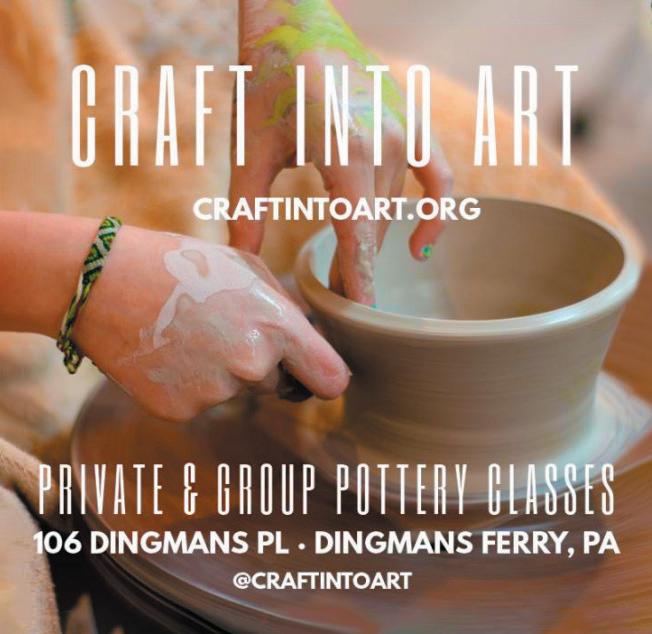




42 (908) 475-3671 • foursisterswinery.com 783 County Rd 519 • Belvidere, NJ Four Sisters Winery WINE TASTING - DAILY Open 6 days a week 11am - 6pm Mon, Tues, Thurs, Sun 11am - 7pm Fri & Sat VINEYARD VIEW BISTRO Fri, Sat noon - 6pm • Sun noon - 5pm Closed Wed CLASSIC CAR SHOW Music, Food & Fun! Sept 15th - 4-7pm • Oct 20th - 4-7pm JAZZ & WINE FESTIVAL Sept • CALL for Details • 12-5pm Wine Tasting FAMILY HARVEST FESTIVAL Oct 7th & 8th • 12-5pm PYO Pumpkins, Live Music Wine Tasting GRAPE STOMPING - MONTHLY Tickets Required MURDER MYSTERY - MONTHLY Tickets Required Private Parties • Weddings • Festivals 912 Main St. Stillwater, NJ Located in the Historic George D. Garris General Store Call Ahead for Pick-Up 973-383-0042 Visit Our Facebook Page for Upcoming Friday Night 4 Course Dinners
OCT 2023 - Kate Hawes teaches

Beginning Carving: Wood Utensils

43






44 Held in charming country setting at Wilbur's Country Store & Barn Shops Sept. 16th & 17th 2023 Saturday & Sunday Rain or Shine From 10 AM - 4:30 PM Crafters & Artists from Four States Great Food Available Serving Our Community For 32 Years Over 100 Cars & Trucks In Stock Prices Starting as low as $13,995 Integrity, Service & Repairs Define a Dealership Open Seven Days a Week Used Car Superstore 131-139 Kingston Ave. (Rt 209N) • Port Jervis, NY 845.856.5104 www.PortJervisAutoMall.com

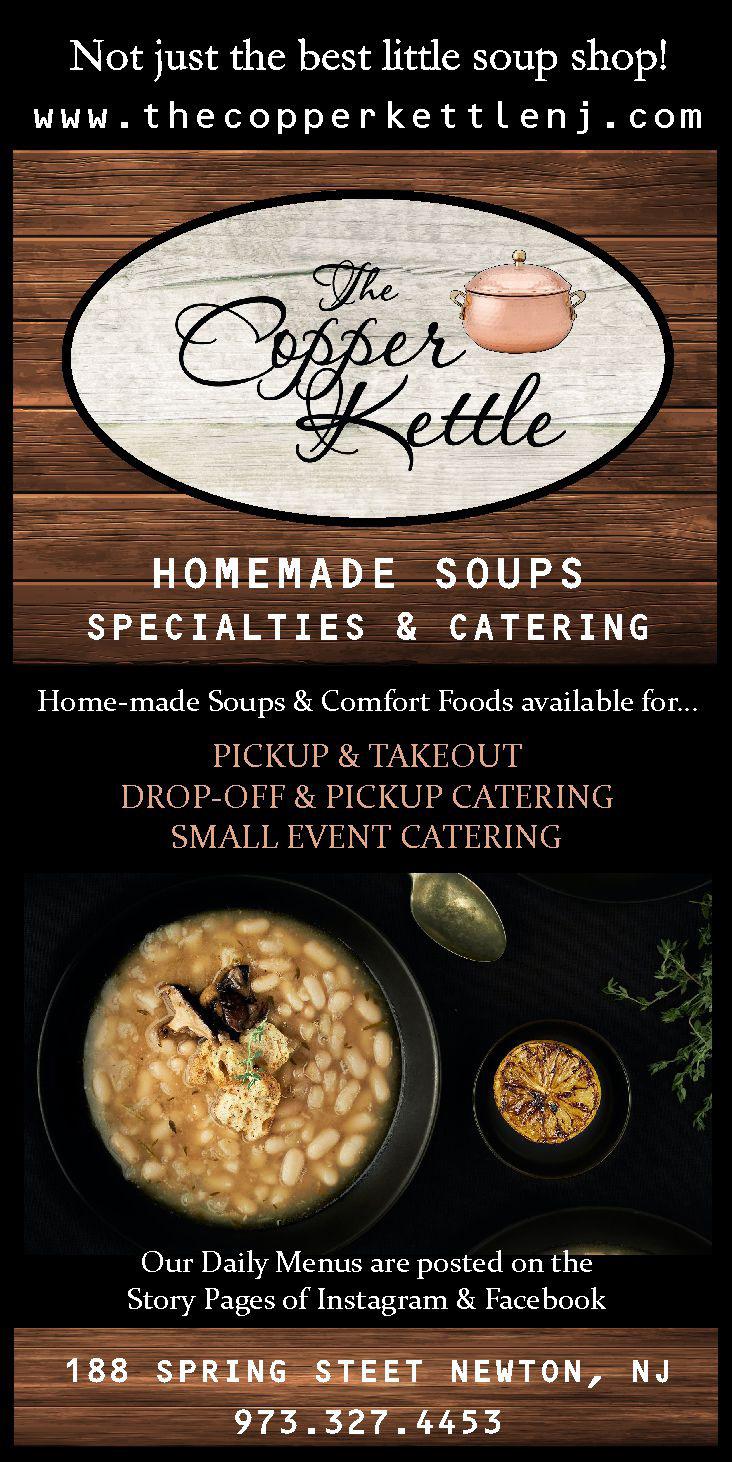

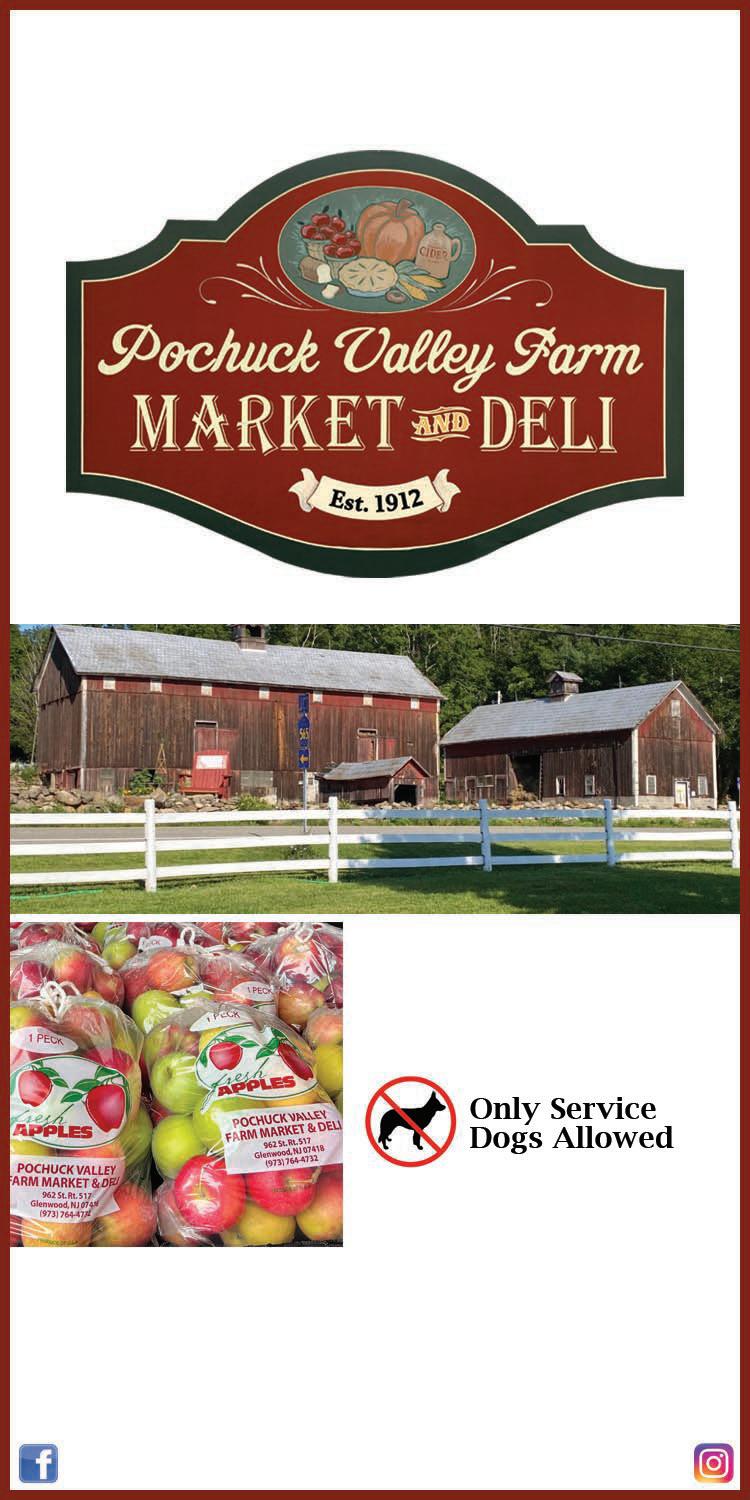
A Unique Crystal & Metaphysical Boutique Salt Room Opening Soon Classes F Healing Sessions F Readings & More 45 Open 7 Days • 6am-5pm Living History Weekend Sept. 30th & Oct. 1st Homemade Apple Cider (Starting 9/15) Baked Goods & Donuts 962 Rt 517 (McAfee Glenwood Rd) Glenwood, NJ • 973.764.4732 www.PochuckValleyFarms.com Pick Your Own Apples & Pears • 7am-4pm 111 Years Family Owned and Operated Book Your Class Trip Today!
Aries (March 20-April 19)
Focus on the quality of what you’re doing, and be cautious about setting any artificial deadlines. You’re involved in something that is going to take as long as it takes. If you submit to that much, it will be easier and proceed more efficiently. If there is love, it’s a creative experience, and it finds its own way.
Taurus (April 19-May 20)
For you to be at home means to be at home with yourself. At the moment, using relationships as a guide will be less effective; you must plot your own course, and this includes socially. The forthcoming Full Moon in Aquarius suggests that others are using you for their orientation, therefore you want your guidance to be coming from within.
Gemini (May 20-June 21)
Accepting that certain things simply must happen and you’re the one who can do it, you will be a lot happier and some unusual but unexpected opportunities will open up. Ask for help when you need it. Your chart suggests you may need to go back to the drawing board on something, and it’s likely that an older version of your schema is more suited to your situation.
Cancer (June 21-July 22)
This is an important time for you to get your finances in order. Look for forgotten or delayed matters, and resolve them. Pluto has temporarily returned to your opposite sign Capricorn, which has the feeling of resolving old business. Cut what does not serve you and invest thoughtfully in everything that does.
Leo (July 22-Aug. 23)
Venus retrograde in your birth sign is one of the most beneficial transits you’ve had in a long time. It’s about learning how to work hand-in-glove with your most important goals, but also embody something deeper: the role you are called to play in society, whatever it may be. Be humbly who you aspire to be, day by day.
Virgo (Aug. 23-Sep. 22)
While there are several important influences coming through Virgo, the connection point is Mars tapping into the wisdom and confidence of Jupiter in Taurus. Any gift is a spiritual one. Underneath whatever may be happening on the level of day-to-day activity, you are connecting with a force that looks like your higher self. Anything you do must be a conscious choice, based on your faith in yourself.
Libra (Sep. 22-Oct. 23)
Your ruling planet Venus moving retrograde is your opportunity to practice sincerity at all times. For example, you get to be the same person with everyone, all the time — rather than mixing and matching to suit what you think is expected. Go past any discomfort and experience the odd joy of being real without compromise.
Scorpio (Oct. 23-Nov. 22)
There seem to be two things going on that are bringing out different facets of your being. One is direct and bold; the other is retreating. It’s likely that these are connected to people. One is teaching you to be your own best friend. The other is teaching you to take over any parental functions that might otherwise be delegated to someone else.
Sagittarius (Nov. 22-Dec. 22)
Make sure that everything do you, every step you take, is solid, and reflects the integrity you want to express in your final result. There are business aspects to what you’re doing, artistic aspects, and practical ones. If you take a long-haul approach, you will be able to keep those in balance.
Capricorn (Dec. 22-Jan. 20)
You are in an unusual stage of your life where you have opportunities to resolve old business, and be done with it. This includes all matters related to the structure of your life, especially financial or involving real property or taxes. You can view the whole experience as a long, living meditation on what really matters to you the very most.
Aquarius (Jan. 20-Feb. 19)
Presently you have an opening to resolve deep, unresolved material with greater than usual effectiveness. Much of what you may be confronting will give way to focused thought and decision-making. You have already done most of the work over a long period of time, and now must claim your accomplishments, and build on them.
Pisces (Feb. 19-March 20)
At times, it’s difficult to identify what you need. You must bring the motivation to improve your life in tangible ways. You have external support available that you can tap into. Stick to those who have proven to be helpful in the past. Then, raise your sail, and get about what you know must be gotten about.
46
Signs Planet Waves by Eric Francis
Read Eric Francis daily at PlanetWaves.net
SAVE THE DATES!
Sussex County Day
September 17
Sussex County Fairgrounds
Augusta NJ
sussexcountychamber.org
52nd Annual
Peters Valley Craft Fair

September 23-24
Sussex County Fairgrounds
Augusta NJ petersvalley.org
Haunted Wild West FestDaytime
September 30 – October 30
Every Saturday & Sunday
Wild West City After Dark
Oct 6 - 30
Friday & Saturday nights
Wild West City
Stanhope NJ wildwestcity.com
Sussex County Harvest, Honey & Garlic Festival
October 21
Sussex County Fairgrounds
Augusta, NJ
sussexfarmvisits.com
Three Weekends!
Sparta NJ Renaissance Festival
September 9-10, 16-17, 23-24
Sparta NJ
spartanjrenfaire.com

Annual Oktoberfest

September 16-17
Mountain Creek
Vernon NJ
mountaincreek.com
Wild West City
Stanhope NJ wildwestcity.com
Jack O’ Lantern
Experience
Oct 1 - 31
Skylands Stadium
Augusta NJ
skylandsstadium.com
Skylands Stadium Light Show & Christmas Village
November 23 – January 1

Skylands Stadium
Augusta NJ
skylandsstadium.com

German Christmas Market of NJ
December 1 – 3
Sussex County Fairgrounds
Augusta NJ
germanchristmasmarketnj.com
OKTOBERFEST
For more information and a complete list of events visit:
of Commerce received funding through a grant from the New Jersey Department of State, Division of Travel and Tourism
RENAISSANCEFESTIVAL sussexskylands.com
The Sussex County Chamber
2023
FALL/WINTER EVENTS
SUSSEX COUNTY DAY




















































































































































































































